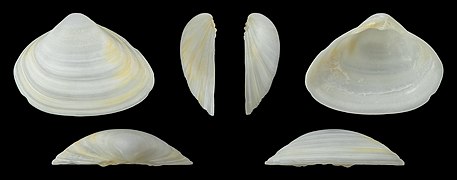Brief Summary
provided by Ecomare
Cut trough shells are found in a narrow stroke along the entire North Sea coast. They rarely found any further out to sea. They are often called spisula. This shellfish is the most important source of food for the common scoter. Eiders also forage on spisula when there's not much other food to find. The shells (fresh and fossil) wash ashore in large amounts on the North Sea beaches. In southern Europe, you often find this shellfish in paella. In that case, they are usually caught elsewhere, such as the Dutch coast. There are some places where it is forbidden to fish spisula, the Voordelta in Zeeland is an example, where they shellfish are left for the birds.
- license
- cc-by-nc
- copyright
- Copyright Ecomare
Spisula subtruncata
provided by wikipedia EN
Spisula subtruncata, the cut through shell, is a medium-sized marine clam, or bivalve mollusc, found in the Eastern Atlantic from Iceland to Morocco and into the Mediterranean Sea. Common and sometimes very numerous. Up to 2.5 centimetres (0.98 in) long, with a distinct triangular shape. [1]
This species of clam is found in sandy and silty bottom in the sublittoral zone, where it lives as a sediment-burrowing filter feeder.
References
-
^ Tebble, Norman (1976). British Bivalve Seashells. Edinburgh: Royal Scottish Museum.

- license
- cc-by-sa-3.0
- copyright
- Wikipedia authors and editors
Spisula subtruncata: Brief Summary
provided by wikipedia EN
Spisula subtruncata, the cut through shell, is a medium-sized marine clam, or bivalve mollusc, found in the Eastern Atlantic from Iceland to Morocco and into the Mediterranean Sea. Common and sometimes very numerous. Up to 2.5 centimetres (0.98 in) long, with a distinct triangular shape.
This species of clam is found in sandy and silty bottom in the sublittoral zone, where it lives as a sediment-burrowing filter feeder.

Right valve

Left valve
- license
- cc-by-sa-3.0
- copyright
- Wikipedia authors and editors
Biology
provided by World Register of Marine Species
This species probably spawns in winter and early spring. The pelagic larval stage seems to last fairly long. S. subtruncata is a suspension feeder and forms an important food item for diving birds like the Common Scooter that overwinter along the Dutch coast (Ziegelmeier, 1957; Wolff, 1973).
Holtmann, S.E.; Groenewold, A.; Schrader, K.H.M.; Asjes, J.; Craeymeersch, J.A.; Duineveld, G.C.A.; van Bostelen, A.J.; van der Meer, J. (1996). Atlas of the zoobenthos of the Dutch continental shelf. Ministry of Transport, Public Works and Water Management: Rijswijk, The Netherlands. ISBN 90-369-4301-9. 243 pp.
- license
- cc-by-4.0
- copyright
- WoRMS Editorial Board
Description
provided by World Register of Marine Species
A solid shell with a more or less triangular shape but assymmetrical: the back is somewhat more rounded than the front. A sculpture of fine concentric lines and grooves cover the shell. The growth lines are clearly visible. Measures up to 30 mm long. Fresh specimens are cream-coloured or yellowish white with a dun epidermis.
Degraer, S.; Wittoeck, J.; Appeltans, W.; Cooreman, K.; Deprez, T.; Hillewaert, H.; Hostens, K.; Mees, J.; Vanden Berghe, E.; Vincx, M. (2006). The macrobenthos atlas of the Belgian part of the North Sea. Belgian Science Policy. D/2005/1191/3. ISBN 90-810081-6-1. 164 pp.
- license
- cc-by-4.0
- copyright
- WoRMS Editorial Board
Distribution
provided by World Register of Marine Species
The distribution area of Spisula subtruncata stretches across the entire Belgian part of the North Sea. In the 1994-2001 period, however, a preference for the near-coastal zone could be observed. Very high concentrations (up to 1,300 ind./m2) were especially observed near the western near-coastal zone.
Degraer, S.; Wittoeck, J.; Appeltans, W.; Cooreman, K.; Deprez, T.; Hillewaert, H.; Hostens, K.; Mees, J.; Vanden Berghe, E.; Vincx, M. (2006). The macrobenthos atlas of the Belgian part of the North Sea. Belgian Science Policy. D/2005/1191/3. ISBN 90-810081-6-1. 164 pp.
- license
- cc-by-4.0
- copyright
- WoRMS Editorial Board
Habitat
provided by World Register of Marine Species
S. subtruncata lives in bottoms consisting of sand and muddy fine sand (Ziegelmeier, 1957; Tebble, 1966).
Holtmann, S.E.; Groenewold, A.; Schrader, K.H.M.; Asjes, J.; Craeymeersch, J.A.; Duineveld, G.C.A.; van Bostelen, A.J.; van der Meer, J. (1996). Atlas of the zoobenthos of the Dutch continental shelf. Ministry of Transport, Public Works and Water Management: Rijswijk, The Netherlands. ISBN 90-369-4301-9. 243 pp.
- license
- cc-by-4.0
- copyright
- WoRMS Editorial Board
Habitat
provided by World Register of Marine Species
Spisula subtruncata occurs in different sediment types: from very fine to coarse sand and from low to high mud content. However, a preference can be observed for rather fine-grained sediments (median grain size 150-250 µm) enriched with mud (mud content of 10-40%). Spisula subtruncata is present in 60% of these sediment types.
Degraer, S.; Wittoeck, J.; Appeltans, W.; Cooreman, K.; Deprez, T.; Hillewaert, H.; Hostens, K.; Mees, J.; Vanden Berghe, E.; Vincx, M. (2006). The macrobenthos atlas of the Belgian part of the North Sea. Belgian Science Policy. D/2005/1191/3. ISBN 90-810081-6-1. 164 pp.
- license
- cc-by-4.0
- copyright
- WoRMS Editorial Board
Morphology
provided by World Register of Marine Species
A solid shell, somewhat triangular in outline with rounded corners. Large specimens reach 25 mm in length. A sculpture of fine concentric lines and grooves covers the shell. The growth stages are clear. It is dirty white in colour, with a greenish or greyish brown periostracum. The inside of the shell is white (Tebble, 1966; Wolff, 1973; Hayward & Ryland, 1990)
Holtmann, S.E.; Groenewold, A.; Schrader, K.H.M.; Asjes, J.; Craeymeersch, J.A.; Duineveld, G.C.A.; van Bostelen, A.J.; van der Meer, J. (1996). Atlas of the zoobenthos of the Dutch continental shelf. Ministry of Transport, Public Works and Water Management: Rijswijk, The Netherlands. ISBN 90-369-4301-9. 243 pp.
- license
- cc-by-4.0
- copyright
- WoRMS Editorial Board



